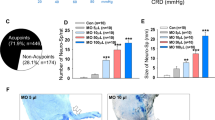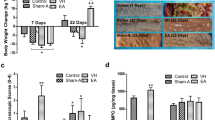Abstract
This project was focused on the study of the effect of the different acupoints on visceral hypersensitivity and the correlation with the brain–gut axis. By using a mouse model of zymosan-induced colorectal hypersensitivity, and observing the response of hypersensitivity model to colorectal distension stimulation in acupuncture at different acupoints, we selected the specific acupoints. With immunohistochemical staining method, we observed c-fos expression, distribution and changes after acupuncture on sensory pathway, including colorectum, spinal dorsal horn and different regions of brain center in the model with colorectal distension stimulation, and evaluated the acupuncture effect on brain–gut axis. The results revealed that the effectiveness of acupuncture for alleviating visceral hypersensitivity was different at individual acupoint, meaning Tianshu (ST25), Zusanli (ST36) and Shangjuxu (ST37) > Quchi (LI11) and Dachangshu (BL25) > Ciliao (BL32). C-fos expression was concentrated in anterior cingulate cortex, hypothalamus, spinal dorsal horn and colorectum in model of zymosan-induced colorectal hypersensitivity and it was down-regulated after acupuncture. The results demonstrates that the acupoint specificity presents in acupuncture for relieving visceral hypersensitivity and the effects are more predominated at the acupoints on stomach meridian innervated by the same or adjacent spinal ganglion segments. The model of zymosan-induced colorectal hypersensitivity can be the animal model simulating brain–gut interaction.








Similar content being viewed by others
Abbreviations
- CRD:
-
Colorectal distension
- EA:
-
Electro-acupuncture
- IBS:
-
Irritable bowel syndrome
- EMG:
-
Electromyographic
References
Wang SJ, Yang HY, Xu GS (2012) Acupuncture alleviates colorectal hypersensitivity and correlate with the regulatory mechanism of TrpV1 and p-ERK. Evid Based Complement Altern Med. http://www.hindawi.com/journals/ecam/2012/483123/
Fond G, Loundou A, Hamdani N, Boukouaci W, Dargel A, Oliveira J, Roger M, Tamouza R, Leboyer M, Boyer L (2014) Anxiety and depression comorbidities in irritable bowel syndrome (IBS): a systematic review and meta-analysis. Eur Arch Psychiatry Clin Neurosci 264:651
Zhang R, Lv H, Qian JM, Li YZ, Hu ZJ (2010) A pilot study of protein fingerprinting in brain–gut interaction model of irritable bowel syndrome. Chin J Intern Med 49(2):134–137
Lv H, Qian JM, Jin GL, Zhou FD, Shen YB (2009) The establishment of an animal model of gut-brain interaction in irritable bowel syndrome for the evaluation of visceral sensation, motility and psychological behavior. Chin J Intern Med 48(12):1035–1039
Christianson JA, Gebhart GF (2007) Assessment of colon sensitivity by luminal distension in mice. Nat Protoc 2(10):2624–2631
Kamp EH, Jones RC, Tillman SR, Gebhart GF (2003) Quantitative assessment and characterization of visceral nociception and hyperalgesia in mice. Am J Physiol Gastrointest Liver Physiol 284(3):G434–G444
Han JS (2003) Acupuncture: neuropeptide release produced by electrical stimulation of different frequencies. Trends Neurosci 26(1):17–22
Feng B, La JH, Schwartz ES, Tanaka T, McMurray TP, Gebhart GF (2012) Long-term sensitization of mechanosensitive and -insensitive afferents in mice withpersistent colorectal hypersensitivity. Am J Physiol Gastrointest Liver Physiol 302(7):G676–G683
Feng B, La JH, Tanaka T, Schwartz ES, McMurray TP, Gebhart GF (2012) Altered colorectal afferent function associated with TNBS-induced visceral hypersensitivity in mice. Am J Physiol Gastrointest Liver Physiol 303(7):G817–G824
Jones RC, Otsuka E, Wagstrom E, Jensen CS, Price MP, Gebhart GF (2007) Short-term sensitization of colon mechanoreceptors is associated with long-term hypersensitivity to colon distention in the mouse. Gastroenterology 133(1):184–194
Masamichi S, Bin F, Gebhart GF (2009) Peripheral and central P2X3 receptor contributions to colon mechanosensitivity and hypersensitivity in the mouse. Gastroenterology 137(6):2096–2104
Furlong TM, McDowall LM, Horiuchi J, Polson JW, Dampney RA (2014) The effect of air puff stress on c-Fos expression in rat hypothalamus and brainstem: central circuitry mediating sympathoexcitation and baroreflex resetting. Eur J Neurosci 39(9):1429–1438
Arout CA, Caldwell M, McCloskey DP, Kest B (2014) C-Fos activation in the periaqueductal gray following acute morphine-3β-d-glucuronide or morphine administration. Physiol Behav 11(130C):28–33
Jorge PE, Phillips JB, Goncalves A, Marques PA, Nemec P (2014) Odours stimulate neuronal activity in the dorsolateral area of the hippocampal formation during path integration. Proc Biol Sci. 281(1783):20140025
Chen Z, Yan Y, Wang K, Xu W, Shi T (1991) An analysis of neuronal responses in nucleus centrum medianum to electrical stimulation of the superficial peroneal nerve. Zhen Ci Yan Jiu. 16(1):15–18
Zhou S, Zeng F, Liu J, Zheng H, Huang W, Liu T, Chen D, Qin W, Gong Q, Tian J, Li Y (2013) Influence of acupuncture stimulation on cerebral network in functional diarrhea. Evid Based Complement Altern Med. http://www.hindawi.com/journals/ecam/2013/975769/
Wu SY, Chen WH, Hsieh CL, Lin YW (2014) Abundant expression and functional participation of TRPV1 at Zusanli acupoint (ST36) in mice:mechanosensitive TRPV1 as an “acupuncture-responding channel”. BMC Complement Altern Med. http://www.ncbi.nlm.nih.gov/pmc/articles/PMC3984709
Qi DB, Li WM (2012) Effects of electroacupuncture on expression of c-fos protein in the spinal dorsal horn of rats with chronic visceral hyperalgesia. Zhong Xi Yi Jie He Xue Bao. 10(12):1490–1496
Kim HY, Hahm DH, Pyun KH, Nam TC, Shim I (2006) Effect of traditional acupuncture on proximal colonic motility in conscious dogs. J Vet Med Sci 68(6):603–607
Ding SD, Ding YJ, Wang XF (2009) Study on thiry patients with slow- transmission constipation treated by acupuncture and moxibustion. Zhong Guo Zhong Xi Yi Jie He Za Zhi. 29(11):1031–1034
Liu HR, Wang XM, Zhou EH, Shi Y, Li N, Yuan LS, Wu GH (2009) Acupunctire at both ST25 and ST37 improves the pain threshold of chronic visceral hypersensitivity rats. Neurochem Res 34(11):1914–1918
Zhou EH, Liu HR, Wu HG, Shi Y, Wang MX, Tan LY, Zhong YS, Jiang Y, Zhang LL (2009) Suspended moxibustion relieves chronic visceral hyperalgesia via serotonin pathway in the colon. Neurosci Lett 451(2):144–147
Tai HQ (2005) Acupoint anatomy. Beijing Science and Technology Press. ISBN:9797530431558
YL Hu (2009) Handbook of acupuncture techniques in small animals. Chemical Industrial Press. ISBN:9787122039699
Acknowledgments
This scientific work was supported by grant from National Natural Science Foundation of China (81072856 and 81373724) to Shao-Jun Wang.
Conflict of interest
The authors declared that they have no competing interests.
Author information
Authors and Affiliations
Corresponding author
Additional information
Shao-jun Wang and Hao-yan Yang have contributed equally to this study.
Rights and permissions
About this article
Cite this article
Wang, SJ., Yang, HY., Wang, F. et al. Acupoint Specificity on Colorectal Hypersensitivity Alleviated by Acupuncture and the Correlation with the Brain–Gut Axis. Neurochem Res 40, 1274–1282 (2015). https://doi.org/10.1007/s11064-015-1587-0
Received:
Revised:
Accepted:
Published:
Issue Date:
DOI: https://doi.org/10.1007/s11064-015-1587-0




